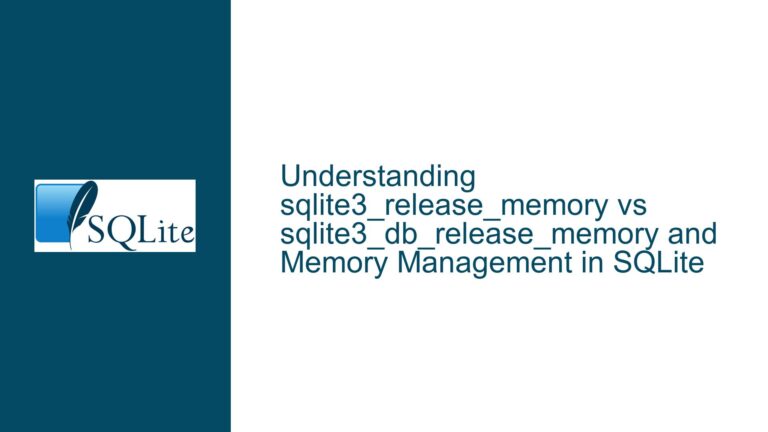Performance Regression in SQLite 3.33.0 with MIN/MAX Queries on Joined Tables
Performance Degradation in MIN/MAX Queries After SQLite 3.33.0 Upgrade
The issue at hand involves a noticeable performance regression in SQLite version 3.33.0 and later when executing queries that utilize the MIN and MAX aggregate functions on joined tables. Specifically, the query in question retrieves the minimum and maximum id values from the events table, filtered by a join with the categories table, and then uses these values to fetch corresponding timestamp entries from the events table. While this query executed almost instantaneously in SQLite 3.28.0, the same query experiences significant slowdowns in SQLite 3.33.0 and subsequent versions.
The schema provided includes tables such as events, categories, labels, process, and thread, with foreign key relationships linking them. The events table contains columns like id, label, channel, process, thread, timestamp, and phase, while the categories table includes id and name. The absence of additional indexes on these tables, combined with the changes in SQLite 3.33.0, appears to exacerbate the performance issue.
The performance regression is particularly problematic because the query is designed to retrieve critical data points efficiently. The slowdown not only impacts the responsiveness of the application but also raises concerns about the scalability of the database as the dataset grows. Understanding the root cause of this regression and implementing effective solutions is essential for maintaining optimal database performance.
Optimization Changes in SQLite 3.33.0 Leading to Query Slowdowns
The performance regression in SQLite 3.33.0 can be traced back to a specific change introduced in the SQLite codebase, identified by the check-in b8ba2f17f938c035. This change was intended to improve query performance by optimizing certain internal operations. However, it inadvertently caused a regression in the execution of queries involving MIN and MAX functions on joined tables.
The optimization in question was designed to enhance the efficiency of query execution by altering how SQLite processes aggregate functions and joins. While the change successfully improved performance in many scenarios, it disrupted a previously optimized path for queries involving MIN and MAX functions. Specifically, the change caused SQLite to lose an optimization that allowed it to quickly identify and retrieve the minimum and maximum values from the events table when joined with the categories table.
The loss of this optimization is particularly impactful because the query relies on the MIN and MAX functions to determine the range of id values that meet the specified criteria. Without the optimization, SQLite must perform additional work to compute these values, leading to increased execution times. This regression is especially pronounced in datasets where the events table contains a large number of rows, as the query must scan more data to identify the required id values.
The issue is further compounded by the absence of additional indexes on the tables involved. While the schema includes primary keys and unique constraints, it lacks indexes on columns like events.channel and categories.name, which are used in the join and filter conditions. The lack of these indexes forces SQLite to perform full table scans or less efficient index lookups, further slowing down the query.
Implementing Query Rewrites and Indexing Strategies to Restore Performance
To address the performance regression in SQLite 3.33.0, several strategies can be employed to restore the query’s efficiency. These strategies include rewriting the query to leverage alternative SQL constructs, adding necessary indexes to the tables, and applying SQLite-specific optimizations.
Query Rewrite: Utilizing Subqueries and Temporary Tables
One effective approach to mitigating the performance regression is to rewrite the query to reduce the complexity of the MIN and MAX computations. Instead of using a single query with a UNION of MIN and MAX subqueries, the query can be broken down into separate subqueries or temporary tables. This approach allows SQLite to optimize each part of the query independently, potentially restoring the lost optimization.
For example, the original query:
SELECT events.timestamp
FROM events
WHERE events.id IN (
SELECT MIN(events.id) id
FROM events
INNER JOIN categories on (events.channel = categories.id)
WHERE categories.name not in ("Lorem", "Ipsum")
UNION
SELECT MAX(events.id) id
FROM events
INNER JOIN categories on (events.channel = categories.id)
WHERE categories.name not in ("Lorem", "Ipsum")
);
Can be rewritten as:
WITH min_max_ids AS (
SELECT MIN(events.id) AS min_id, MAX(events.id) AS max_id
FROM events
INNER JOIN categories ON (events.channel = categories.id)
WHERE categories.name NOT IN ("Lorem", "Ipsum")
)
SELECT events.timestamp
FROM events
WHERE events.id = (SELECT min_id FROM min_max_ids)
OR events.id = (SELECT max_id FROM min_max_ids);
This rewrite uses a Common Table Expression (CTE) to compute the MIN and MAX values once and then uses these values to filter the events table. By separating the computation of the MIN and MAX values from the retrieval of the timestamp values, the query can potentially benefit from SQLite’s optimization strategies.
Indexing Strategy: Adding Indexes on Join and Filter Columns
Another critical step in restoring query performance is to add indexes on the columns used in the join and filter conditions. In the provided schema, the events.channel and categories.name columns are used in the join and filter conditions but lack indexes. Adding indexes on these columns can significantly improve the efficiency of the query by reducing the number of rows that need to be scanned.
For example, the following indexes can be added to the events and categories tables:
CREATE INDEX idx_events_channel ON events(channel);
CREATE INDEX idx_categories_name ON categories(name);
These indexes allow SQLite to quickly locate the rows that match the join and filter conditions, reducing the overall execution time of the query. Additionally, the indexes can improve the performance of other queries that involve these columns, providing a broader benefit to the database.
SQLite-Specific Optimizations: Leveraging PRAGMA Statements
SQLite provides several PRAGMA statements that can be used to optimize query performance. For example, the PRAGMA journal_mode statement can be used to configure the journaling mode of the database, which can impact the performance of write operations. Additionally, the PRAGMA cache_size statement can be used to adjust the size of the database cache, potentially improving the performance of read operations.
For example, the following PRAGMA statements can be used to optimize the database:
PRAGMA journal_mode = WAL;
PRAGMA cache_size = -2000;
The PRAGMA journal_mode = WAL statement enables the Write-Ahead Logging (WAL) mode, which can improve the performance of concurrent read and write operations. The PRAGMA cache_size = -2000 statement sets the cache size to 2000 pages, which can improve the performance of queries that access large amounts of data.
Testing and Validation: Ensuring Correctness and Performance
After implementing the query rewrite, indexing strategy, and SQLite-specific optimizations, it is essential to thoroughly test and validate the changes to ensure they restore the query’s performance without introducing new issues. This testing should include executing the query on representative datasets, measuring the execution time, and verifying the correctness of the results.
Additionally, it is important to monitor the performance of the database over time to ensure that the changes continue to provide the desired benefits. This monitoring can include tracking the execution time of critical queries, analyzing the database’s resource usage, and identifying any potential bottlenecks.
Conclusion: Restoring Performance in SQLite 3.33.0
The performance regression in SQLite 3.33.0 with MIN and MAX queries on joined tables is a significant issue that can impact the responsiveness and scalability of applications. By understanding the root cause of the regression and implementing effective solutions, it is possible to restore the query’s performance and ensure the database continues to operate efficiently.
The strategies outlined in this guide, including query rewrites, indexing strategies, and SQLite-specific optimizations, provide a comprehensive approach to addressing the performance regression. By carefully applying these strategies and thoroughly testing the changes, it is possible to mitigate the impact of the regression and maintain optimal database performance.
In conclusion, while the performance regression in SQLite 3.33.0 presents a challenge, it also provides an opportunity to refine and optimize the database schema and queries. By leveraging the techniques and best practices outlined in this guide, developers can ensure their databases continue to perform efficiently, even in the face of changes and updates to the underlying database engine.






